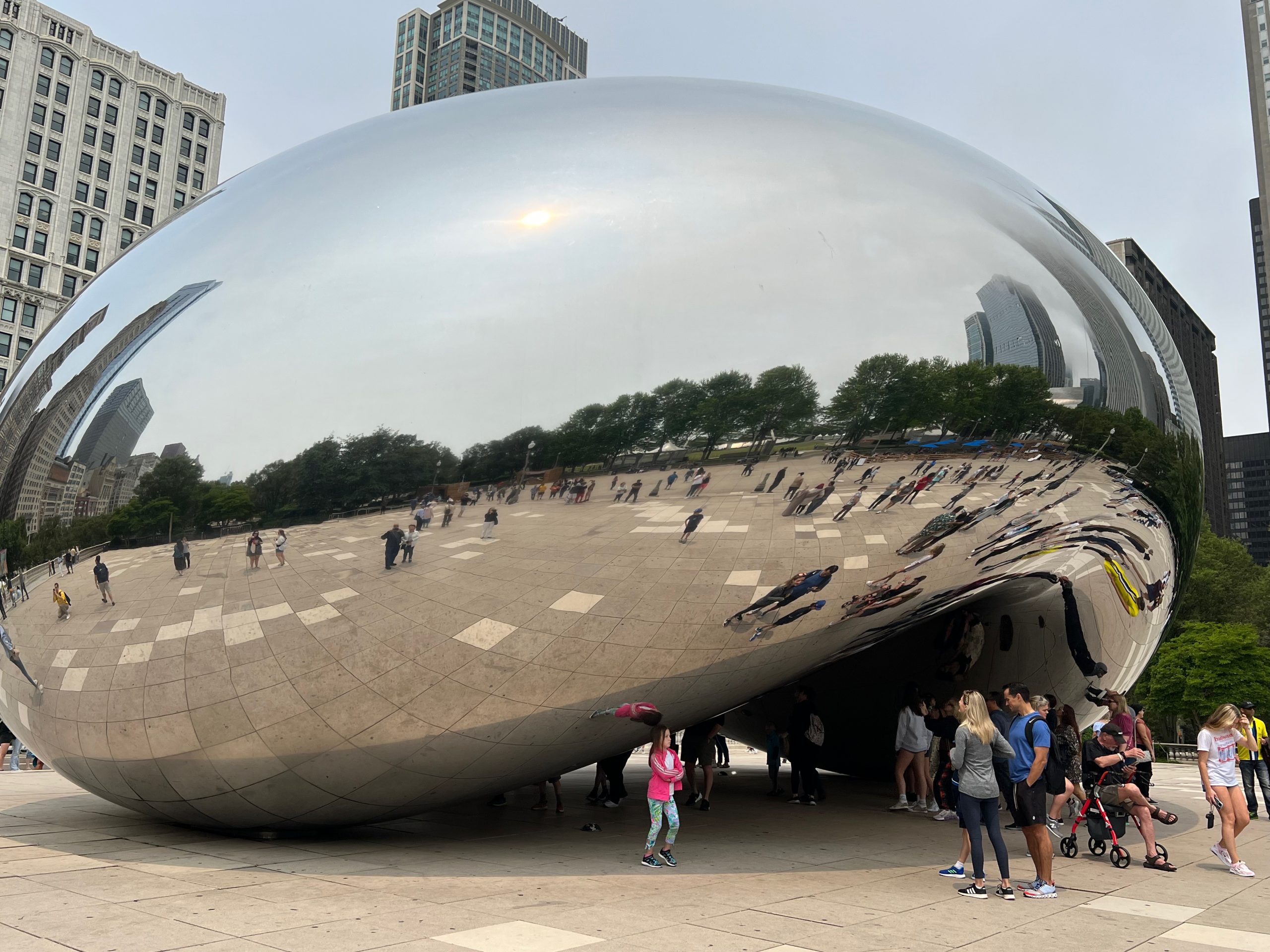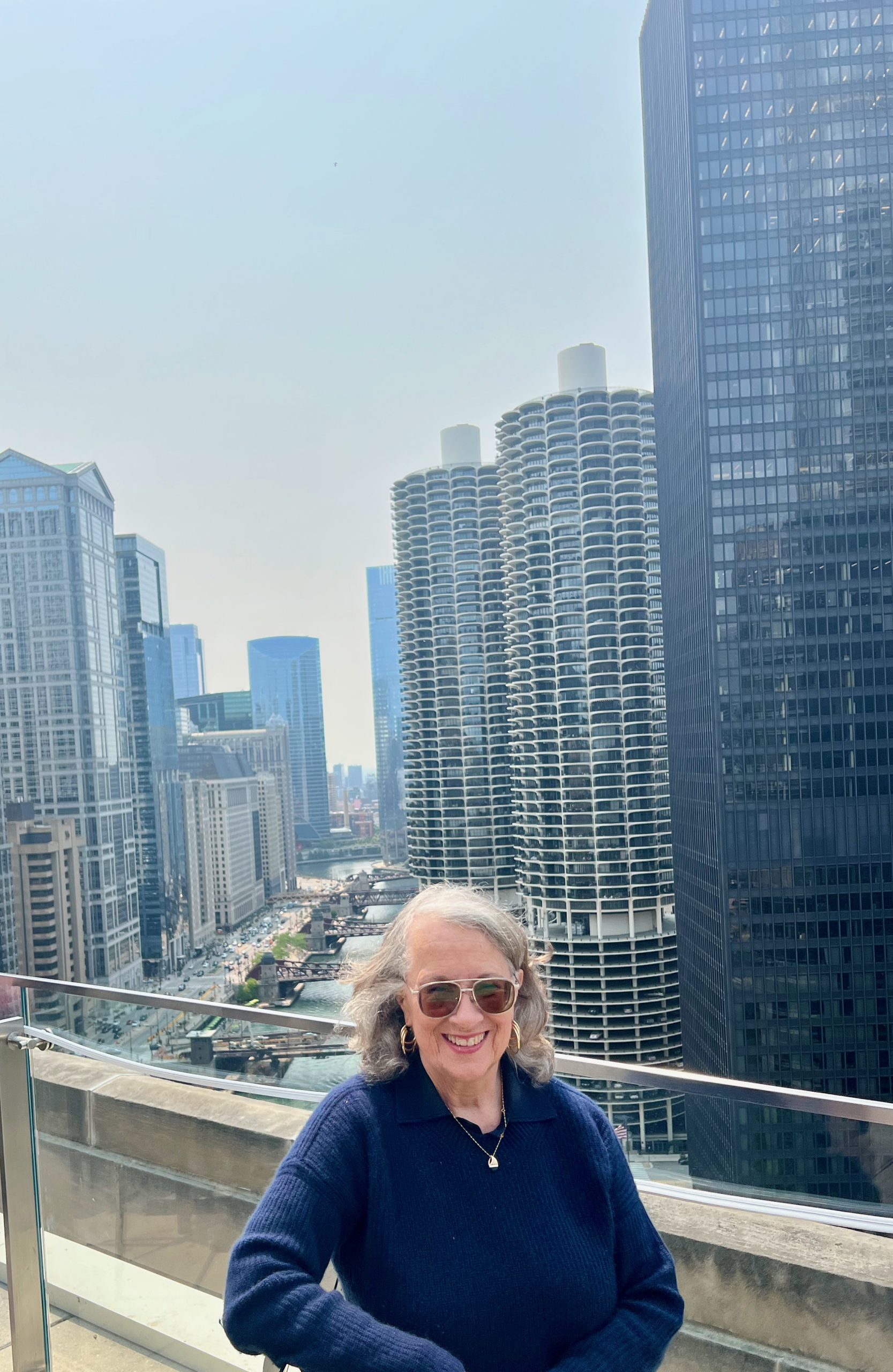Blog
Spring Showers…Ideas Blooming…Book Tours in the Rain
Four out of the first six book events for my new novel The Far Side of the Desert occurred in the rain with downpours in two cities. Such is the peril of a March pub date, but better than snowstorms in January. A pleasant surprise was how many friends and new readers showed up anyway. A cozy bookstore on a rainy day or evening has its own appeal.
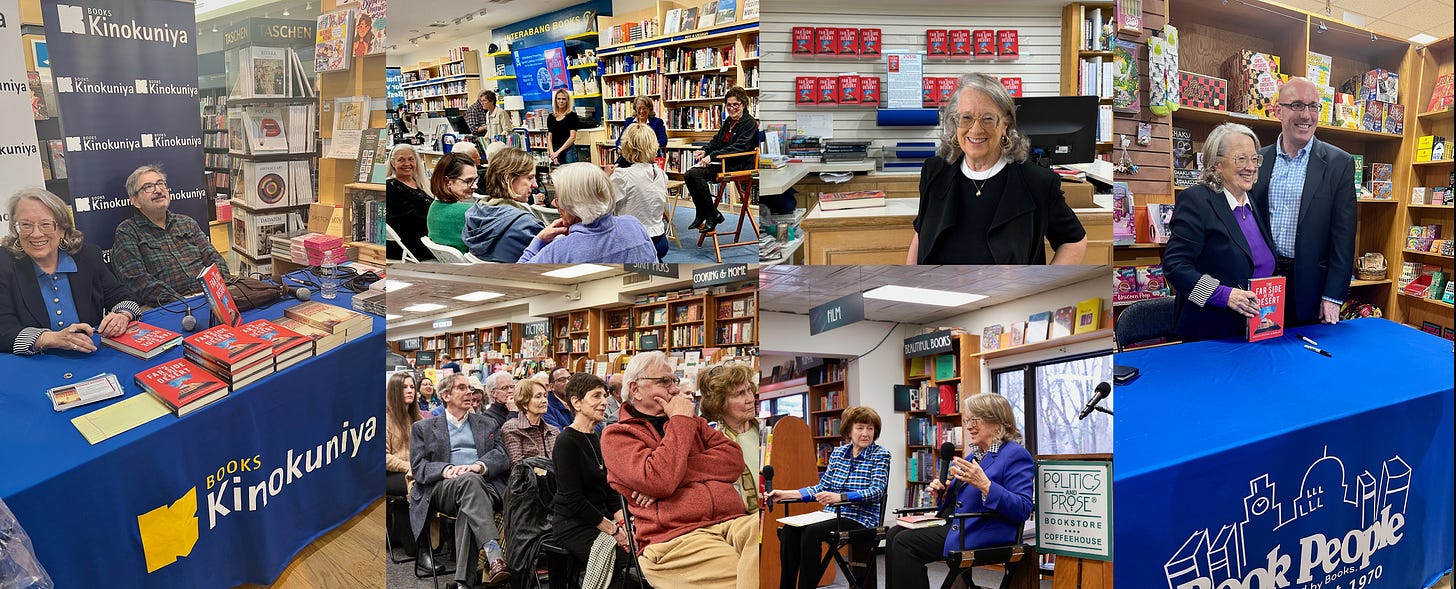
Still on the road, I’m grateful to all those who value books and ideas and friendship and particularly the independent bookstores that host the gatherings. However one comes into contact with ideas and with the experience of others, horizons open and thought expands, both for the writer and the reader. Expanding thought and perceived experience is how we grow.
We are privileged to be able to share books and ideas, a freedom of expression and assembly not to be taken for granted. Ideas are the food of healthy societies, and books are one of the vehicles for these. A tour across the U.S. highlights this privilege which shrinks with censorship and almost disappears if the writer is put behind bars as is the case in too many countries.
Each month in my Substack I feature a writer at risk who is not as fortunate but is targeted by governments threatened by conflicting ideas.
May the power of ideas and imagination and the freedom to write endure and expand.
Join me on Substack
The Far Side of the Desert
July, 2007
A Moorish king and queen bobbed momentarily above Samantha Waters’s scrambled eggs as if waiting to be fed. Outside the second-floor windows of the Hostal dos Reis Católicos, 12-foot puppets of kings and queens and devils and saints peered into the dining room then lurched away toward the square. Samantha leaned over the balustrade and filmed the festivities on the plaza below.
“Let’s go, Monte,” she urged her sister who was hunched over the wooden table with a plate of pancakes. “We can get coffee on the plaza.”
Outside, the smell of coffee and fresh almond cakes rose from pushcarts as pilgrims hurried past shaking tambourines, beating drums and filling the morning air with sound. Somewhere bagpipes played. The sun was already baking the cobblestones in the square where tables and chairs had been set up.
“It’s too crowded,” Monte complained as they merged with a stream of dancers and musicians. “This is a security nightmare!”
“It’s a festival!” Samantha spotted an empty table and tossed her black straw hat over the heads of other spectators to claim it. They’d arrived late last night, she from London and Monte from the U.S. Embassy in Cairo. At breakfast they’d read the guidebook which explained how a monk in the 9th century had discovered the body of the Apostle in a vault in the King and Queen’s home village. The village had been celebrating its destiny ever since….”
So begins my new novel The Far Side of the Desert which comes out March 5 and can be ordered now. It is the story of a diplomatic family, including two sisters and a brother, pulled into the nexus of a global plot when one of the sisters is kidnapped at a festival. No one asks for ransom or contacts the family about her whereabouts or why she was taken. Moving from Spain to Cairo to Washington to London to Morocco to Gibraltar, The Far Side of the Desert is a family drama and a political thriller that explores the links of terrorism, crime, and financial manipulation and the grace that ultimately foils destruction.
I hope you’ll read and be engaged by the story, the characters, and the themes. If you are, I hope you’ll tell friends, write a review, make a little noise.

Like my novel Burning Distance which published last year, The Far Side of the Desert is a story written and re-written over many years.
Shared here is the backstory from the Author’s Note:
I first visited Santiago de Compostela, Spain—the opening scene in The Far Side of the Desert—in 1993 as a delegate to PEN International’s 60th Congress. The PEN Congress coincided with the Festival of St. James and the Camino de Santiago where tourists and pilgrims gathered on the plaza in front of the massive Baroque and Romanesque cathedral. The PEN Congress was an entirely separate event, but the festivities overlapped in the square.
Salman Rushdie made a surprise visit to the Congress, one of his first since the fatwa had been issued against him. At that Congress I was elected the Chair of PEN International’s Writers in Prison Committee, the division of PEN that spearheads PEN’s human rights work on behalf of persecuted writers worldwide so I was one of a small group who greeted and shared dinner with Rushdie. I mention these events because it was there I began contemplating what it would be like if one had to disappear or was disappeared, either by choice or coercion. That question is central to the opening of The Far Side of the Desert. What happens when all the familiar props of life are taken away?
There are many events, much research and intertwining threads that develop in The Far Side of the Desert, but the seed of imagination began in Santiago de Compostela and at the end of the Camino on the rugged cliffs of Galicia facing west over the Atlantic. It is here the ancient Romans thought the world ended, a spot they called the Cape of Death because the sun died there and because ships wrecked on the rocks that jutted out into the sea. The Romans saw nothing westward and could imagine nothing but terrors so they declared Non plus Ultra: There is nothing beyond.
Imagining what is beyond, discovering what holds and what falls away is the journey of the two sisters Monte and Samantha Waters who are from an American diplomatic family. The outer frame of the story includes drug and arms trafficking, money laundering, and financial manipulation—a membrane of crime that smothers large parts of the globe. But the core is the characters and the journeys of their hearts and minds.
Join me on Substack
One Voice…One Thought…One Oyster Shell at a Time
Sitting in an easy chair with my laptop desk and computer, I look out over the river on this winter’s day—frozen ground, chunks of ice littering the lawn, an American flag fluttering out the window and four white Adirondack chairs by the water ready for occupants in the spring. The land and the river edged with ice abide as we wait for leaves to fill in the skeletal trees, though the magnolia remains in leafy bloom though without flowers.
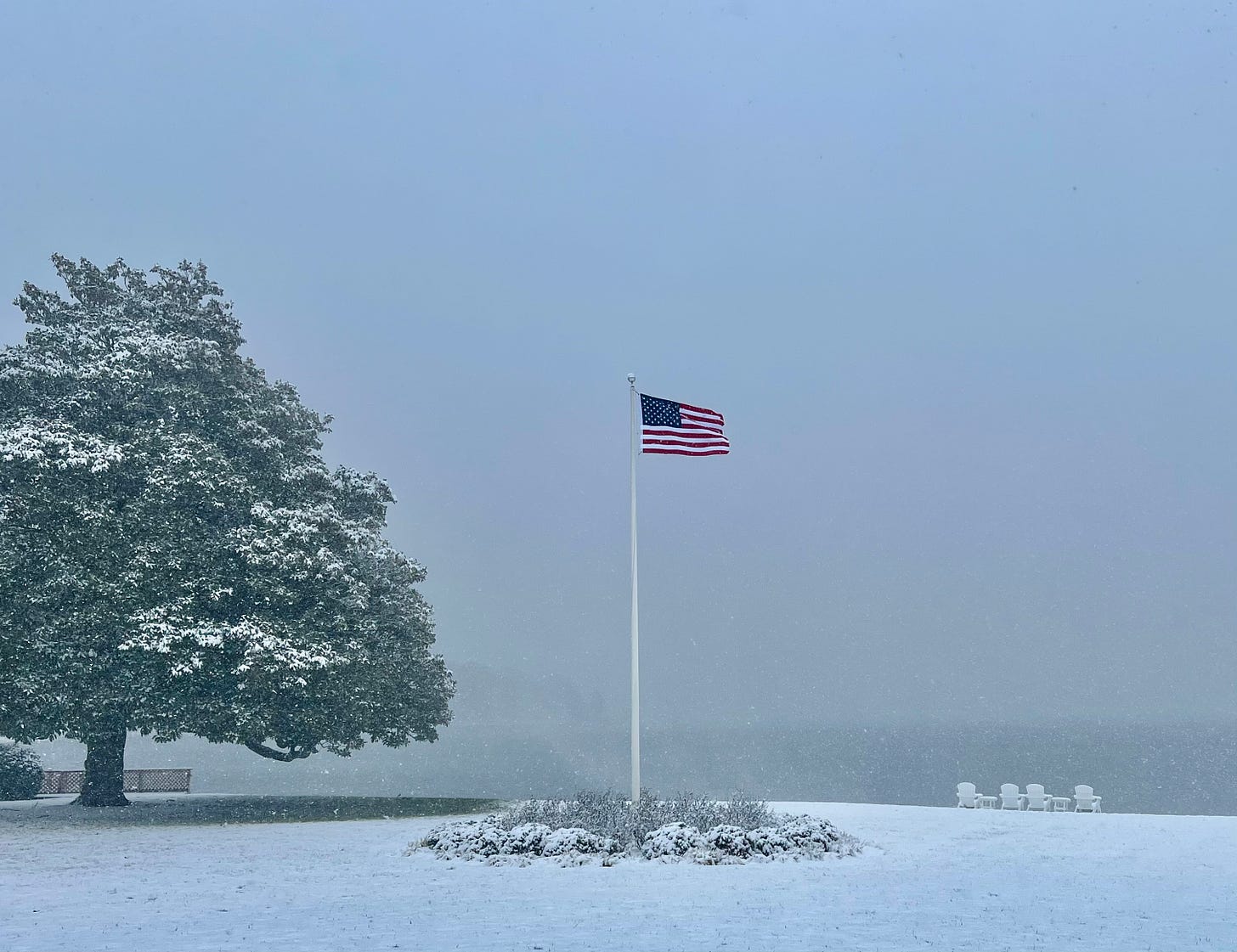
Outside this quiet winter scene, the world continues to roil both at home and abroad. In the US, a presidential election is moving nearer as the first primaries have gotten underway, though certain campaigns have been going on relentlessly as if the campaigning never stopped between elections. It is an exhausting dance of our democracy, and this year is especially fraught. America’s politics this time round feels more like that of some other country’s…maybe Italy’s?—though our system assures whoever ascends to power will likely be ensconced for four years. Our door does not revolve so easily to usher leaders in and out.
One friend distressed by this year’s election decamped to New Hampshire, scene of the second primary, to do what I’m not sure, but to be there and work and participate in this every-four-year process of choosing. That these early choices take place in even colder weather with frozen hard ground and the buds of spring even further away perhaps pays homage to the rugged winters that greeted our earliest forefathers.
As I sit comfortably in my chair, I contemplate what role most of us not directly connected have, both at home and in conflicts abroad. Is it enough to watch from afar, to stay informed? For what purpose and what action?
I was always taught that my thought and my voice mattered. I was responsible for how I thought even if it wasn’t recorded or couldn’t be directly acted upon. How I thought was my responsibility to add beneficence to the global stream of thought. Offering as wise and pure a contribution as I could was like dropping a small purification tablet into the much larger pool. Just as one small tablet can purify 25 gallons of water, a single thought can uplift a community.
I live parttime on the Eastern Shore of Maryland where phalanxes of citizens work to keep the rivers clean so they and their children can rely on the rivers for fish and crabs and their children can swim in the waters, but it takes work by the citizenry. One of the facilitators helping purify the waters are the oysters that live in the rivers. A single oyster can filter 50 gallons of water a day, straining out the impurities. In the 1600s when John Smith first sailed down these rivers, the waters of the Chesapeake renewed with fresh water every two or three days. Now it is more like every 600 days, according to the Shore Rivers project which works to clean up and keep clean the rivers of the Chesapeake.
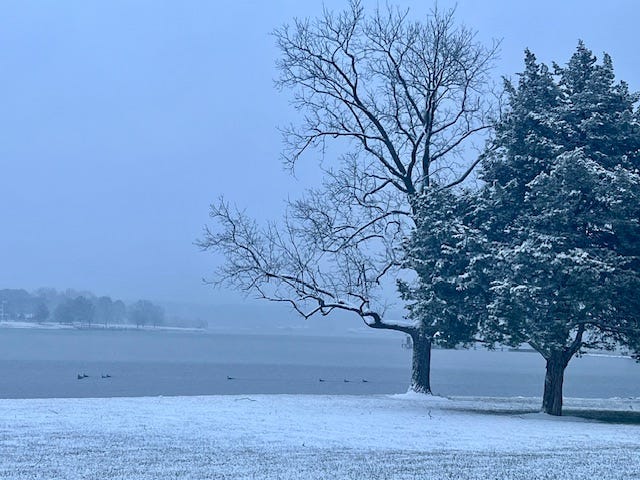
One oyster purifying 50 gallons of water each day! It is a remarkable dynamic. A successful project has been launched to repopulate the rivers with oysters, just one of many methods to clean the rivers. The effort is paying off.
At the risk of stretching the comparison, it is interesting to consider how one’s individual clear, honest, caring, selfless thought might purify a community of thought, dissolving and straining out anger, recrimination, untruths, vitriol, excessive grievances…whatever the issues of polity might be.
In the river I look out on, oysters have been growing on the bottom and are purifying the water daily. I carry hope that we citizens too can clean up the muck in the discourse and fabric of our individual lives, community, and globe one thought, one oyster shell at a time.
Join me on Substack
Sunrise and a Wish
Sometimes I lose myself in the sunrise. I watch the earth’s slow motion as the sun creeps above the horizon, first as a streak of red light in the dark sky expanding into yellow-orange-pink and then the sun itself peeking above the horizon and breaking into a full orbed golden disc lighting up the landscape.
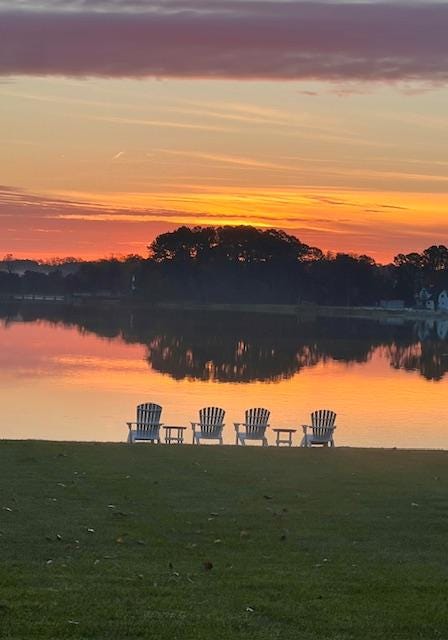
Knowing this same movement is witnessed around the world confers a kind of unity for the earth. When conflicts seem fraught and discourse harsh in politics and among citizens, when solutions appear elusive, I watch the sun rise and take comfort that it will do so day after day no matter what we on earth are doing. It symbolizes a larger force and deeper meanings we often miss, absorbed as we are in our own day to day.
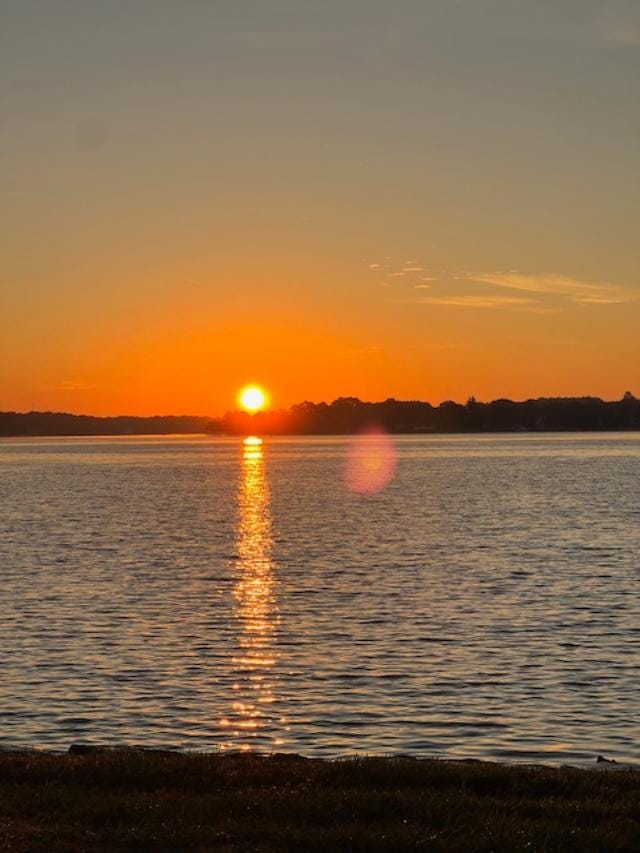
Though I may not grasp the fuller meaning, I know it is there. I recognize the qualities that enable me to glimpse the outlines. An essential is gratitude. The season of Thanksgiving in the U.S. and a few other countries, of the holidays which celebrate the arrival of wisdom and wise men and women, be it Christmas, Hannukah, Eid, Kwanzaa, Diwali. Often these are celebrated with lights strung up to illumine the darker months. Light has long been the metaphor for wisdom as darkness flees before it because it can’t exist when light is present. Darkness is only the absence of light.
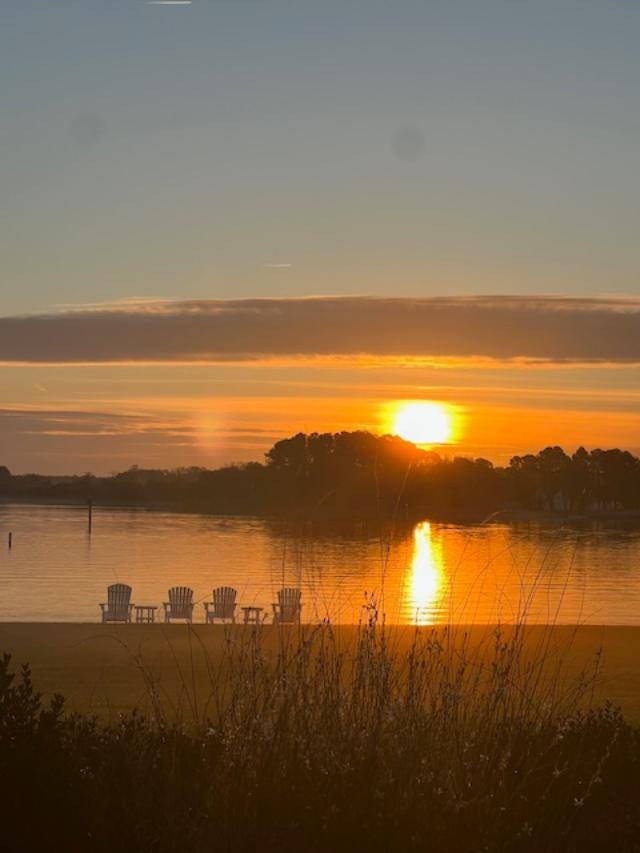
As we head into this season, I hope to do so with a listening thought for the wisdom waiting and a regarding eye to see pathways that may yet appear and connect. Wishing for peace seems too facile, but perhaps wishing for an understanding heart and the way to defuse violence and meanness of spirit. Acknowledging that conflict may continue among people but seeking ways to take the violence out of it and to find ways to exist together, that seems more obtainable. May we stand in wonder as the sun rises wherever we are and may our thoughts let in the light and open outward.
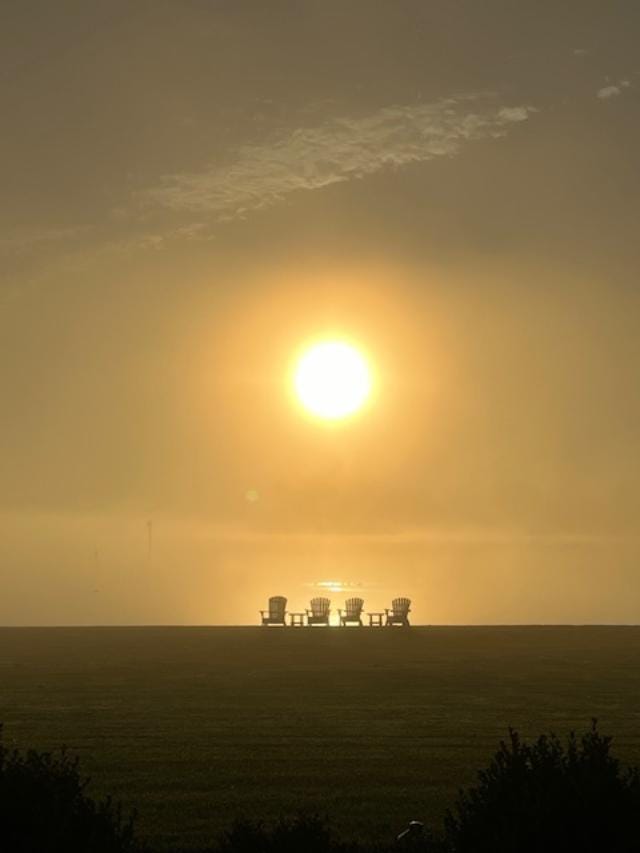
In an Unspeakable Time…Thanksgiving…Gratitude?
It is lunchtime on a blue sky day in Washington, DC. Outside on the restaurant patio where I’ve had breakfast and have been writing, patrons sit among red and pink flowers and flora tinged with autumn discussing the tangle of Washington politics—still no Speaker of the US House of Representatives at this writing a week ago—chaos in the Middle East after unspeakable brutalities and destruction, intensive fighting continuing in the Ukraine and the borders of Russia. There is a sense of the world pulling apart at the seams of international order.
We have felt stress and strain before, but for historic and emotional reasons, this period feels more acute. Yet the sun is shining, and the patterns of daily life remain uninterrupted for most Americans, including those in Washington, DC. The disruption is in our personal response and emotional reaction to the events at home and abroad.
When friends and acquaintances grow especially upset by political events, I sometimes quietly ask, “Did the President call you today?” Or “Did your Senator, House representative manage to reach you for advice?” No. Though our advice and feelings are often shared with anyone who will listen, in a democracy, our voice is usually heeded indirectly, at least on national and international matters.
We rely on our ability to think and feel freely to interpret events we have no direct role in shaping unless perhaps we’re in the media whose function is to inform so we citizens can react intelligently. We can write letters, text, phone, join peaceful demonstrations and let our views be known. We can join organizations, political and nonpolitical, contribute our work, wealth, and wisdom to effect change, but as a citizenry, our direct opinion is only sought every few years at the ballot box.
So how can we contribute to a more harmonious outcome in world affairs, or even local affairs utilizing our freedom to think and to speak? Tragedies often bring societies together to help each other and unite, but when societies define themselves in oppositional terms, unity and goodwill quickly dissipate and turn into a hardened will to dominate and prevail.
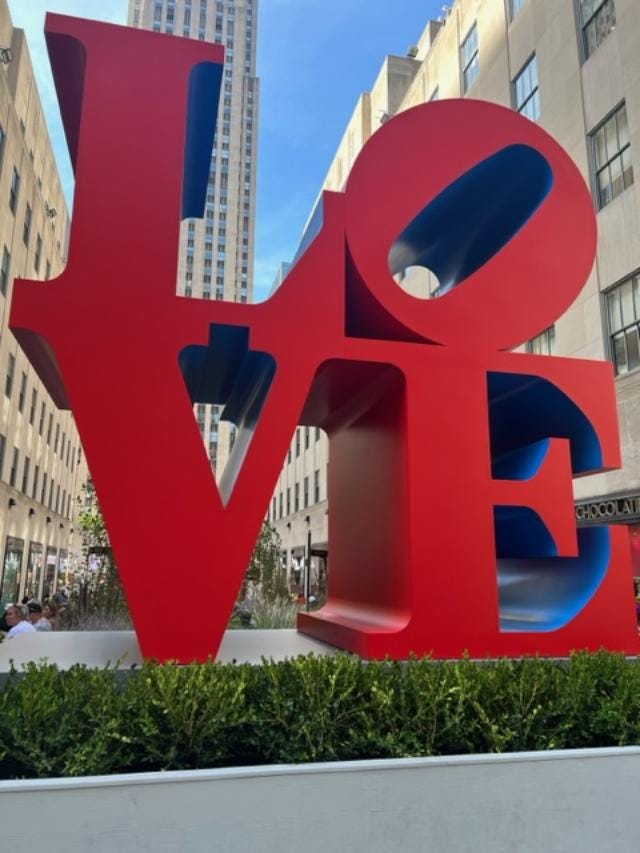
As a writer, words have been my medium, even if the reach is circumscribed. But as I’m watching alarming events and behaviors thousands of miles away in the Middle East and in Europe, words feel inadequate to resolve and to inspire.
The primary mandate in Article 1 of the United Nations Charter is “to maintain international peace and security and to that end to take effective collective measures for the prevention and removal of threats to the peace, and for the suppression of acts of aggression or other breaches of the peace.” Is this the goal, the light to be sought and followed? How can the individual citizen’s thought and actions contribute?
The only answers I have come to begin with one. Begin with each. Begin with the smallest, yet largest need to see the good, a good, and build from there. The risk of Pollyanna thinking is profound. I hear voices deride, but my hope is that here is the beginning of prayer which can link to a higher and benevolent Principle governing us all. Yet even as I write that, I hear the commentator this morning saying, “If politicians begin with ‘I hope…’ they have already lost. Hope is not a strategy.” So perhaps not hope, but determination to find and build upon that which words only represent—love, humanity, freedom.… Are those adequate words? What are the words? Or perhaps where is the thought? I sometimes wish I were a musician. I can almost hear the harmony in my head, but I don’t know how to render the notes….
Join me on Substack
On the Edge of the UN
The week of the United Nations General Assembly (UNGA) meeting is full of targeted and chaotic energy from around the world. I was there by chance last year with all the traffic snarls, blocked streets and crush of crowds, especially on the day the U.S. President was in town. I vowed to avoid that week forevermore.
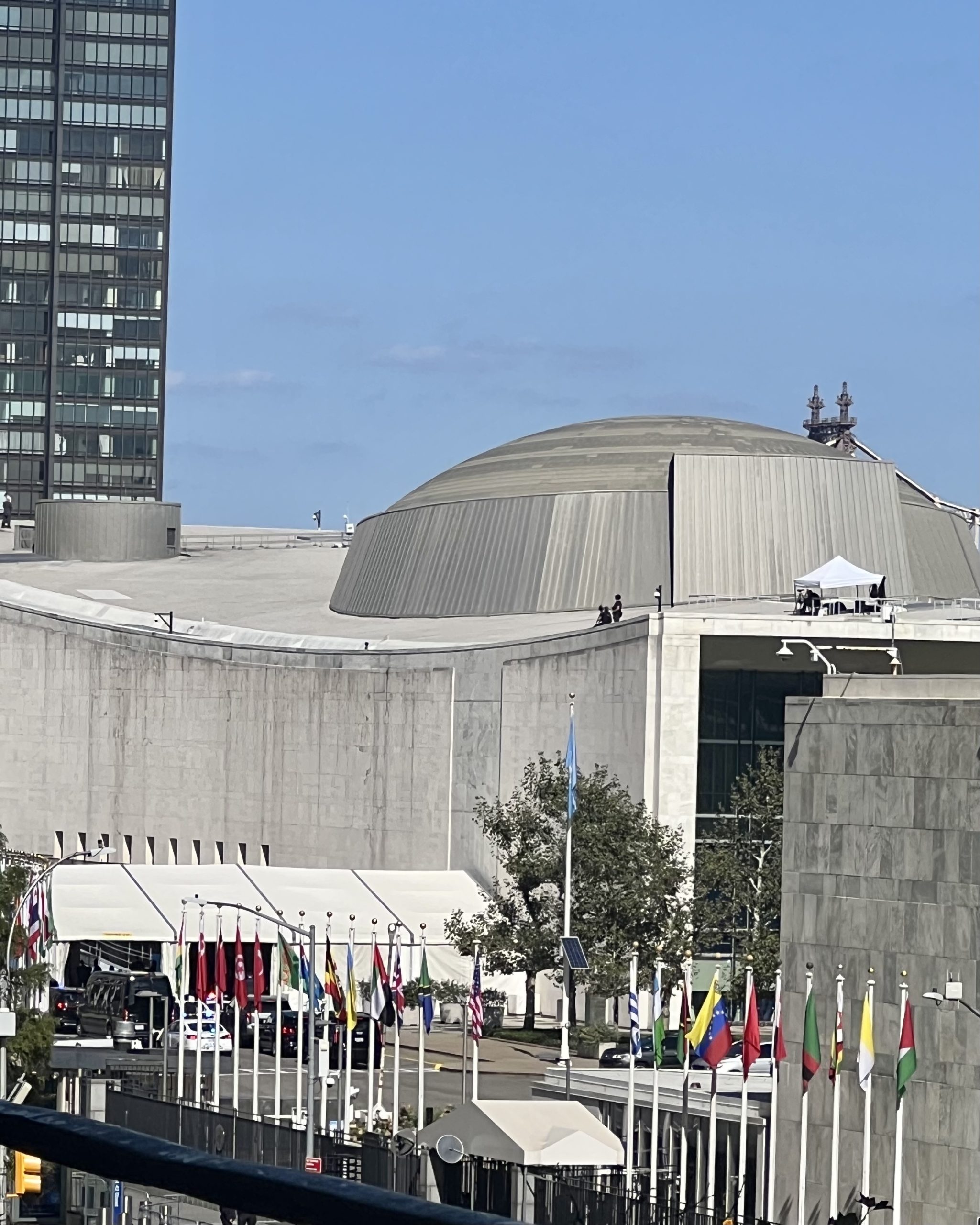
Flags of the United Nations during General Assembly week, September 2023.
But this year with a meeting I could only get on Monday and another on Friday and various events and meetings in between during mid-September, I called to book a hotel, only to find hotels were sold out and the price of the few available rooms had skyrocketed. Alas, I realized it was the week of the UNGA.
I finally managed to find a hotel not costing the price of a car down payment. With more experience, I scheduled meetings I could walk to, and, with the exception of the first day when torrents of rain doused the city, the weather cooperated with sunny fall days. New York bristled with the added energy of the United Nations General Assembly in town as delegates from around the world walked the streets in all the finery and dress from African, Asian, and Latin American countries.
The larger question is what was accomplished at the UN General Assembly. That remains to be seen at this writing, but there are a few hopeful signs. At the least there is something heartening about seeing representatives from the nations of the world come together in anticipation of getting along long enough to solve global problems affecting us all like climate, migration, and armed conflict.
For those of us born after World War Two—and that now includes most of the world’s population— there is a compelling desire to avoid such a conflagration again. Those who witnessed with optimism the fall of the Berlin Wall and a turn towards democratic government in Eastern Europe and around the world in the 1990s are now alarmed by the return of authoritarianism. Signs of stress on the international governing systems are mounting.
There continues to be a need beyond the United Nations for international forums where problems can be addressed and solutions crafted. In August I had the opportunity to visit one institution which keeps watch over a crucial pilar of free societies—the free press and its free flow of information. In late summer I visited Radio Free Europe/Radio Liberty (RFE/RL) whose mission is to promote democratic values and report accurate, uncensored news in countries where the press is threatened and disinformation abounds.
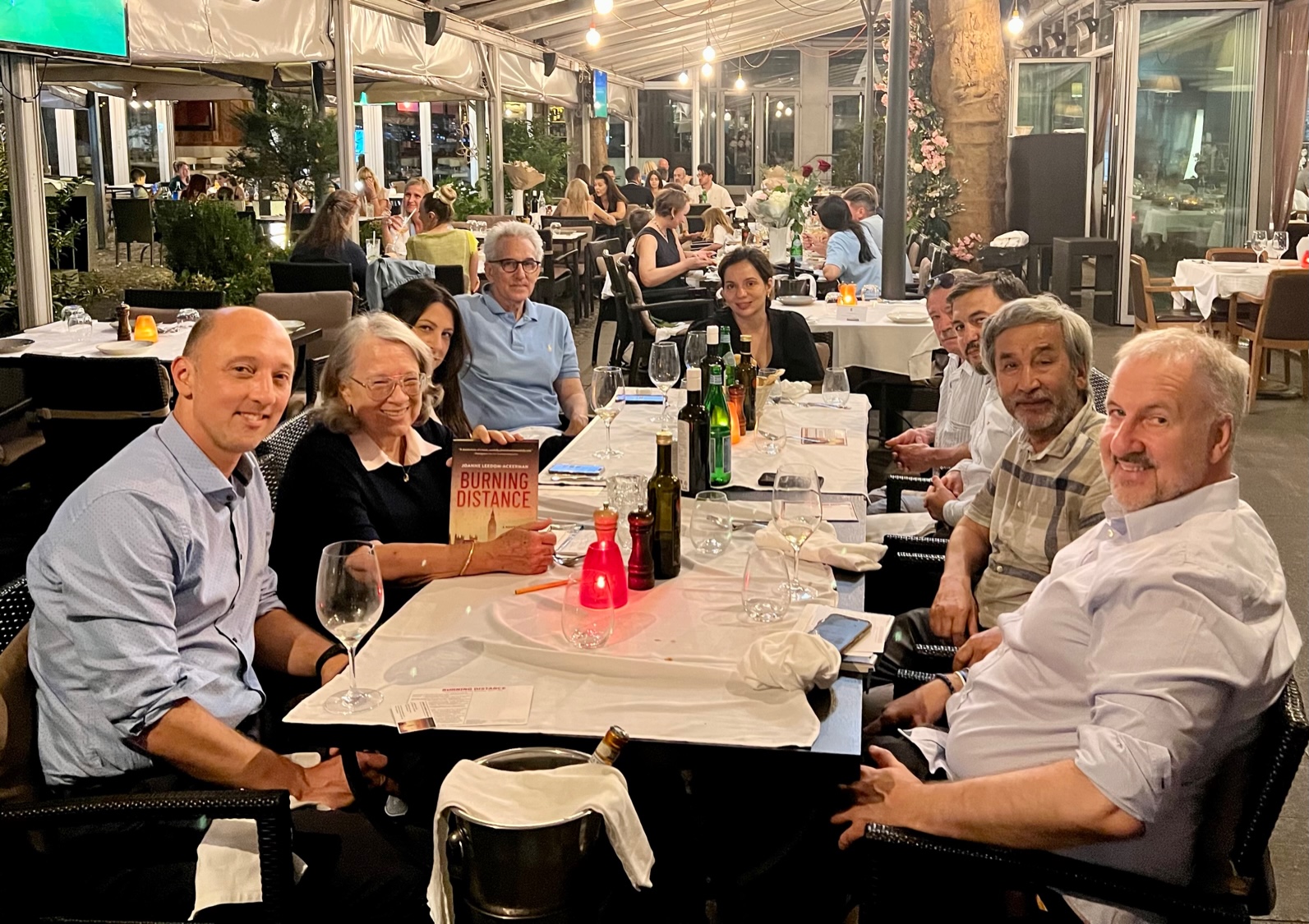
Dinner with journalists from Radio Free Europe/Radio Liberty in Prague, discussing writing, my novel Burning Distance and current affairs, August 2023.
Headquartered in Prague on a secure and sprawling campus, RFE/RL employs 700 journalists around the world to research, write and broadcast stories that uncover corruption and advocate for free societies and their institutions like independent judiciaries and free press. With large newsrooms and correspondents who report the news in 27 languages in 23 countries where a free press is banned or works under threat, RFE/RL is on the front lines.
As the newsrooms of traditional press shrink and the numbers of foreign correspondents dwindle, it was heartening to walk through the halls and newsrooms at RFE/RL and sit around a table with experienced journalists from Europe, the Middle East, and Latin America who have resources available to investigate and report critical stories. Logging a weekly audience of 40 million and 869 million yearly visits to its website and 15 billion annual video views, RFE/RL is one of the most comprehensive news operations in the world with 21 local bureaus and an additional 1300 freelancers and stringers plus two bureaus in the U.S.
Approximately 1500 hours of radio programming are also broadcast every week where listeners can tune in on shortwaves. RFE/RL has a network of partner organizations that rebroadcast across 11 time zones. However, in the current climate, rebroadcasting is prohibited on local outlets in Azerbaijan, Belarus, Iran, Pakistan, Turkmenistan, Tajikistan, and Uzbekistan, and journalists are under increasing threat and censorship. RFE/RL’s website has been blocked in Crimea, its broadcasts jammed; the website is blocked in Iran where the bureau was closed and banned from FM and the Internet in Azerbaijan, and the accreditation stripped from journalists in Tajikistan, Turkmenistan, and Uzbekistan.
Registered as a private, nonprofit corporation, RFE/RL is funded by a grant from the U.S. Congress through the United States Agency for Global Media (USAGM) as a private grantee. Major policy decisions are made by its independent Board of Directors, the majority of whom are career journalists and human rights specialists. To guarantee journalistic credibility, a “firewall” was part of the enabling legislation and prohibits interference by U.S. government officials, including USAGM’s Chief Executive Officer, with the objective of producing independent reporting of the news. Journalists and editors make the final decisions on what stories to cover and how they are covered, according to Jeffrey Gedmin, the interim CEO of RFE/RL.
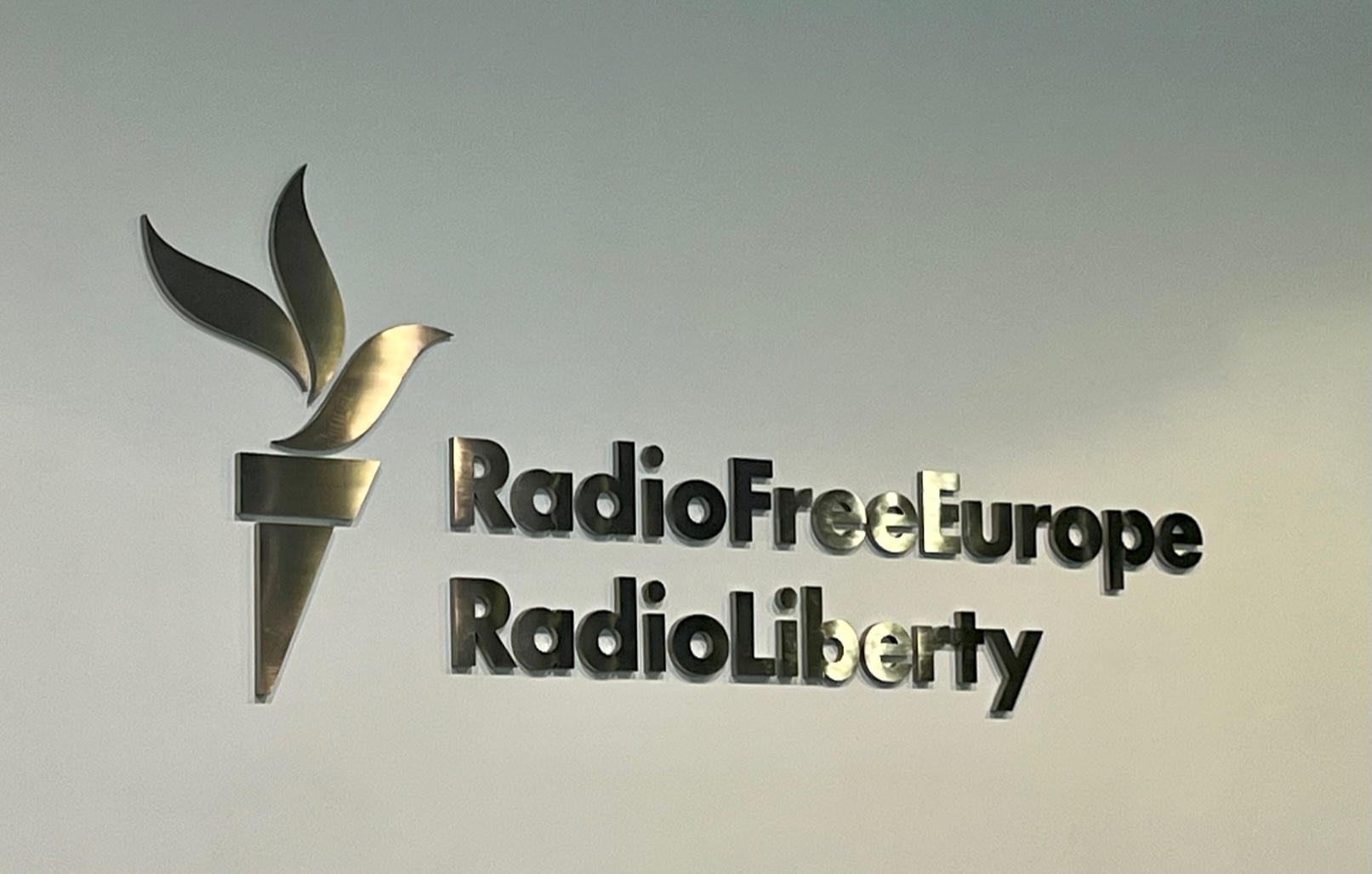
Headquarters of Radio Free Europe/Radio Liberty in Prague, Czech Republic.
Recent RFE/RL stories include lengthy investigations into corrupt practices in Russia where it reaches Russian-speaking audiences and beyond via the Current Time digital and 24/7 television network. Other stories include reports on the cease fire between Azerbaijan and Armenia in Nagorno-Karabakh and Azerbaijan’s military operations in the region; Ukrainian infantry breaking though Russian defenses, including a live briefing of Russia’s invasion; Iranian deputies vote to toughen penalties for women flouting the dress code; Georgian President Mikheil Saakashvili’s trial in Tbilisi.
Join me on Substack
In London…Again!
I spent part of August in London, one of the centers of the universe for many of us English literature majors in college and life. Though I revere Russian literature and have read great novels from Japanese, Ukrainian, Indonesian, Indian, Chinese, Nigerian, French, German and other cultures, these have all been in English translation. I have visited these countries, but I haven’t lived in the countries and cultures. However, I did live in central London on several occasions in my life—first in college, then in my first year of marriage and for six years with my husband and young sons, who were influenced by their experience living abroad, especially during the first Gulf War.
As a college student I lived on my own in London for three months the summer between my junior and senior year in college, working as a receptionist at The Christian Science Monitor where I published my first story in an international newspaper—a feature with photos on Hyde Park Speakers Corner.
As I wandered old haunts this summer, particularly the great parks of London—Kensington Gardens, Holland Park, and Hyde Park—I moved among memories even as I observed current London. It is no coincidence that my recent novel Burning Distance and my next novel The Far Side of the Desert (March 2024) are in part set in London with characters who live there. Both novels required a good deal of research into issues of trafficking—arms, drugs, and people—as well as money laundering and financial manipulation, the smothering membrane that encompasses large parts of many societies.
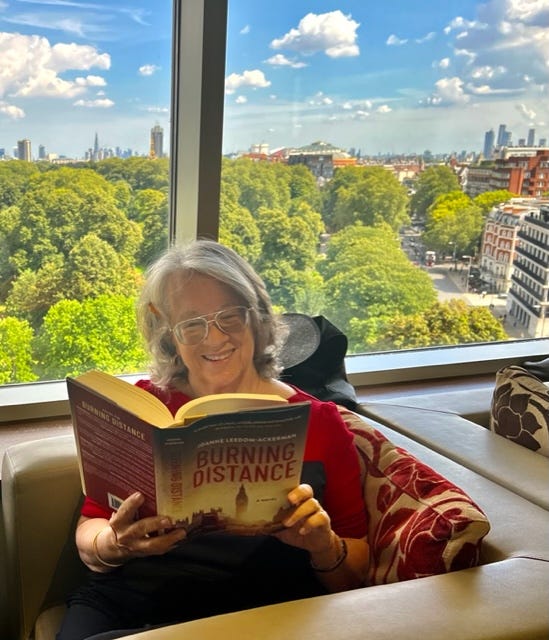
At a restaurant in London overlooking Kensington Gardens and Kensington High Street.
But research is just the beginning, providing the context of the outer world. A novel works to the extent the author penetrates the inner world of characters and knits inner and outer worlds together into a story. It is the characters who drive the story. As a former journalist, I want to be assured that I have the factual context as accurate as possible so that when imagination and invention take off, I know the platform from which it launches.
The Far Side of the Desert opens in Santiago de Compostela, Spain and flashes to London, Washington, DC, dwells for a time in the Sahara Desert then accelerates to Morocco and Gibraltar and the historic area where the ancients claimed the world ended as two sisters—Monte and Samantha Waters, one a diplomat, the other a TV journalist—get drawn into a criminal vortex.
For me, as for most writers, the process of writing is a journey of discovery. I’m led by the sleuth/journalist in me, one clue leading to another, and by the best friend or mother, listening to what the characters have to say for the characters develop their own voices and view. While the writer has created them, the characters also inform, letting the author glimpse the fullness and creative nature of Mind.
I’ve been writing for years, and in the odd flow of life, my novels are now finding their readers. I hope you’ll be one of them. The Far Side of the Desert can be pre-ordered, and Burning Distance, published March 2023, is available now and will come out in paperback February 20, 2024 with the opening chapter of The Far Side of the Desert included.
I hope you’ll order, read, tell friends, and leave reviews and comments. Thank you! Happy reading!
Join me on Substack
On The Yellow Brick Road
![]() I’m launching a newsletter on Substack at the encouragement of my publisher. My Substack “On the Yellow Brick Road” will officially launch in September with the announcement of my new novel coming out March 2024. Those current subscribers and/or those who have received regular notice of my blog posts are automatically subscribed. If you aren’t subscribed, I hope you will be.
I’m launching a newsletter on Substack at the encouragement of my publisher. My Substack “On the Yellow Brick Road” will officially launch in September with the announcement of my new novel coming out March 2024. Those current subscribers and/or those who have received regular notice of my blog posts are automatically subscribed. If you aren’t subscribed, I hope you will be.
This monthly newsletter will include my blog post, along with news about my work and literary events, a focus on a writer at risk in the world you can learn about and on whose behalf you may want to take action. It will include a bit of whimsy with a word or two you may never have occasion to use, but if you’re like me, words you like to know to expand vocabulary, and a list of resources for freedom of expression. I’d also love to hear what you would like included as regular or irregular features.
The Substack allows comments and interactions more easily among readers and other Substacks, I’m told. Like many, I’m trying to keep up with the shape-shifting platforms of digital and social media in order to expand connections with readers and friends. If you’ve read my blog posts over the last 15 years—could it really be 15 years—I hope you’ll continue. My Substack is free, and you can subscribe by clicking here. I’ll try to keep the whole enterprise a short and enjoyable read with substance. I look forward to hearing from you.
A former journalist, I spend most of my writing time these days on fiction in a lifelong admiration for what literature can do. Good literature reveals characters and orders life into stories the reader can connect with and understand. We all live and remember our lives and the lives of others through the stories we tell and are told. History, politics, even religion are rendered through stories.
Because storytellers can be powerful members of society, the storytellers—usually the writers—are often the early persecuted, imprisoned and even killed in authoritarian societies as a result of the stories they tell. I’m a storyteller as are many of my friends and family who are journalists, fiction writers, dramatists and poets. We are fortunate to live in a country that, while stressed at the moment with the banning and censoring of books, still does not put its writers in prison or kill them, though the increasing pressure to ban books is alarming. Freedom of expression includes the freedom to have access to ideas. Imagination has always been the enemy of the tyrant because it can’t be controlled. I’ve spent time over the last many decades working on behalf of writers who don’t have the same protections and working with organizations that defend freedom of expression.
In my own novels—in particular my recently published novel Burning Distance and my next novel The Far Side of the Desert to be published March 2024—I’ve sought insight through narrative. Both books took a good deal of research into the factual context of the story and the inner journeys of characters. In naming my newsletter On The Yellow Brick Road, I pay tribute to L. Frank Baum’s iconic novel The Wonderful Wizard of Oz. Interpretation is extensive on the many elements of this story and of the Yellow Brick Road in particular. According to commentary:
Collaboration, communication, innovation, positivity, nurturing, and fun are the six core values of Yellow Brick Road. The values emphasize team spirit, transparent two-way communication, support for new ideas, nurturing of bonds and relationships, a positive, solution-based mindset, and a fun learning environment.
Is that a mission statement? It sounds a bit like a gathering of strategic modelers at a conference. I’m not aiming for a didactic newsletter, but I think the values hold. I’d also like to have some fun and explore new thoughts and occasionally inspire.

Other commentary notes:
With the help of her newly-minted friends, Dorothy is able to melt the Wicked Witch of the West and save the citizens of Oz. No matter what the situation is, you should never allow that to get in the way of your morals.
With the help of new and old friends, I look forward to embarking on this path, alert to occasional wicked witches but mostly exploring ideas large and small. Thank you for coming along.
Bird Song…
I greet the day early each morning listening to bird song when I’m in the country—chirping, whistling, trilling as the sun rises. The birds tweet all around me, warbling up and down the musical scales with their own rhythms and melodies. I don’t see many of the birds, except when the bird feeder is full. They are high in the trees, occasionally swooping out over the river then disappearing again. All the while they continue their songs and conversation among themselves and to each other.
This week I came across an app on my phone that will identify a bird by its photo or by its sound. I’ve downloaded this electronic savant and now aim my phone and its microphone towards the dominant sound and am given the name of the bird. I’m still deciding if I’ve taken the magic away from my moments or have enriched my morning. I now know I’m serenaded at various times by House Wrens, Bluebirds, Mockingbirds, Blue Jays, Brown-headed Cowbirds, Bobwhite Quails, Purple Marlins, Wood Thrushes, Chickadees, House Sparrows, Western Meadowlarks, Kingbirds, Flickers, Merlin’s, Tufted Titmouses, Sandpipers, Golden-crowned Kinglets, a Ruby-throated Hummingbird, Anna’s Hummingbird, a Great Blue Heron, an Osprey and some days a Cardinal and Crows and at night by a Great Horned Owl, a Barred Owl, a Screech-Owl, a Pygmy Owl and now an Alder Flycatcher. Could there really be that many different birds? I’ve been adding names and sounds ever since I downloaded the app and each day record new bird songs.
As autumn arrives, the sounds will be enhanced by ducks and geese who will arrive for the winter. I wonder if the birds distinguish among themselves and their flocks? Do they talk only to their own or also to each other? They often sing at the same time with the sounds layering on each other like some celestial disco. Do they compete for space in the skies and trees? Or do they party and sing together?
Ornithologists no doubt have the answers, or at least informed observations. Over time, I’ll read more on my new app about these birds and their habits. For now, I’ll keep the birdfeeder filled and try to enjoy my flighty neighbors with more knowledge and appreciation though maybe with some of the symphonic magic drawn from the morning.
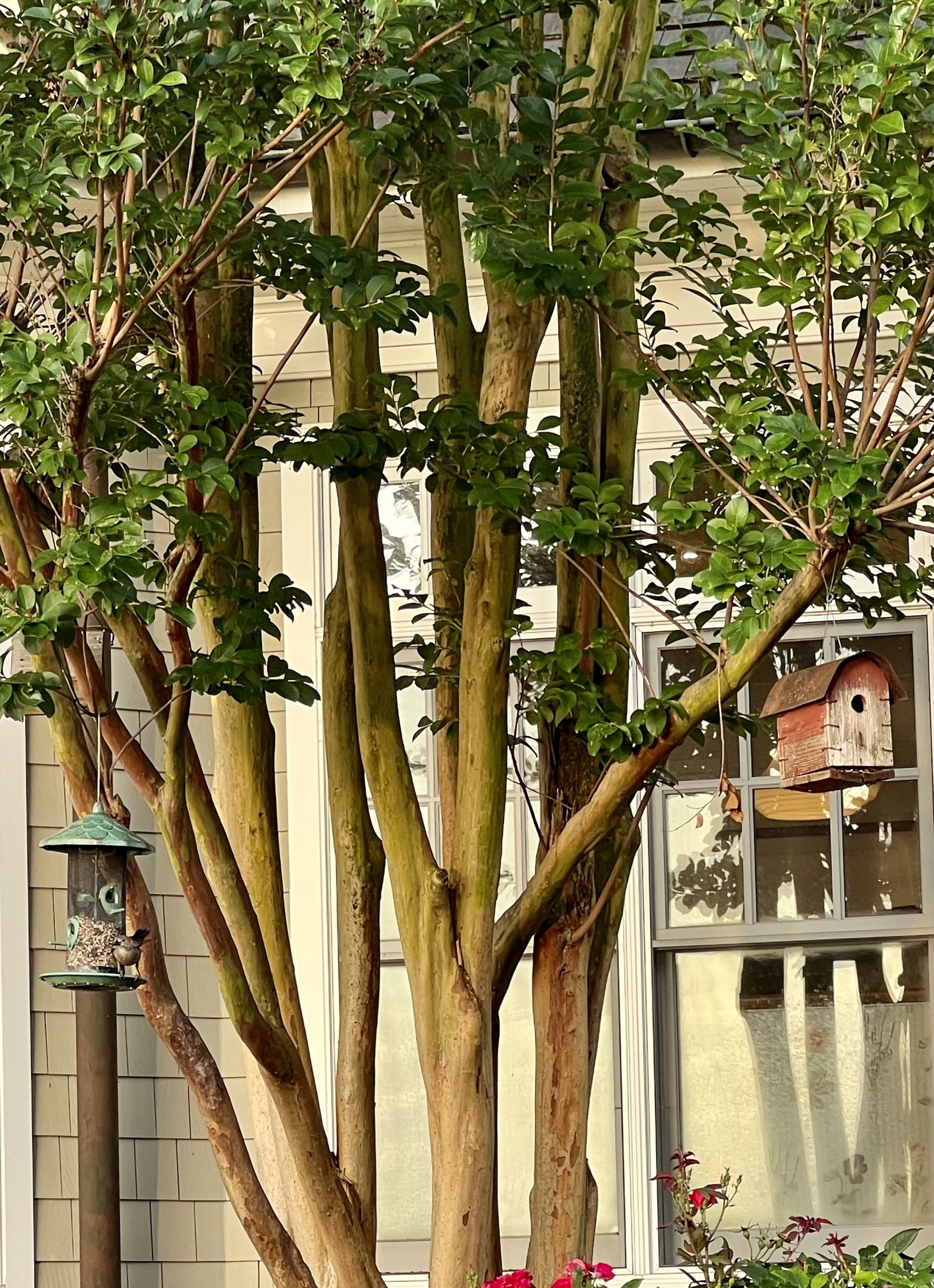
The Longest Day in a Spinning World
The summer solstice June 21 slid by on a cloudy chilly day with buckets of rain on the Eastern Shore of Maryland so that I barely noticed the longest day.
As summer officially begins, the light starts to retreat as the earth tilts slowly away from the sun, at least in the northern hemisphere. Whatever the vagaries on the surface—politics, wars, elections, hurricanes, coups or celebrations—the earth moves imperceptibly beneath our feet.
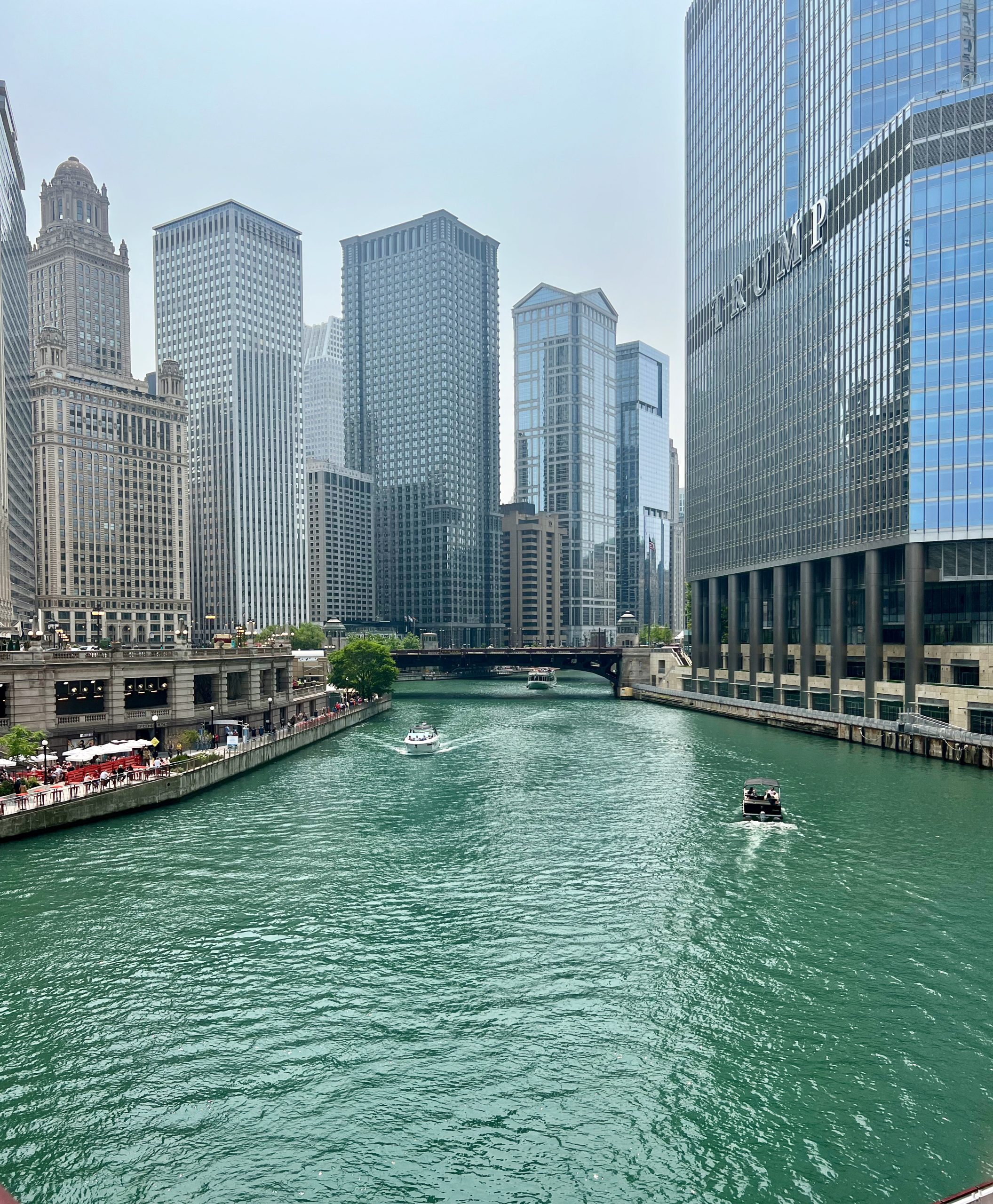 For me, June before the solstice meant a week in Chicago with book events, significant for my new novel Burning Distance and for an interview with Lisa See about her new novel Lady Tan’s Circle of Women and an energized discussion with novelist Sara Paretsky about censorship and banned books, the latter events at the American Writers Museum.
For me, June before the solstice meant a week in Chicago with book events, significant for my new novel Burning Distance and for an interview with Lisa See about her new novel Lady Tan’s Circle of Women and an energized discussion with novelist Sara Paretsky about censorship and banned books, the latter events at the American Writers Museum.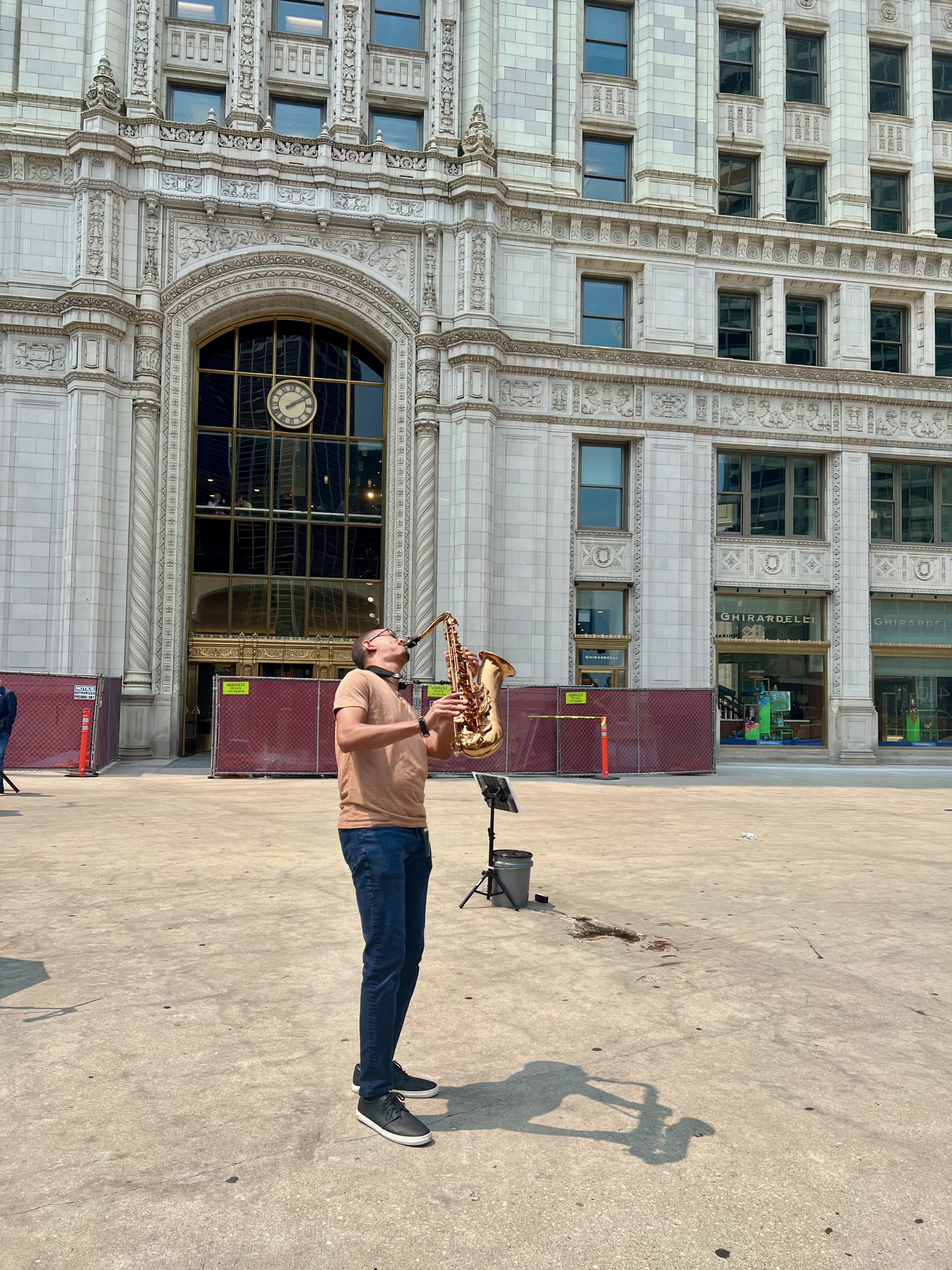
On this trip, I fell in love with Chicago, a city I’ve visited before but never for as long a stretch. Walking along Michigan Avenue from Millennium Park with detours down to the Chicago River and up to the rooftop of London House, I passed (and contributed to) a musician on almost every street corner playing the sax or French horn or violin or music from a box. I had a soggy sprint to an opening night of a new musical at the Goodman Theater.
While the earth spins beneath us, Chicago reminds us to enjoy the moments—cold or hot, windy or still, pouring rain or bright sun (sometimes all in the same 24 hours)—and to enjoy the music.
The song heralds: “Bet your bottom dollar, you’ll lose the blues in Chicago.”
And the universe echoes back!
